6 Best Vertical Pull Exercises (with Pictures!)
Ideally, every back workout will involve some sort of vertical pulling movement to help round out back muscle development in the lifter.
While a vertical pulling movement traditionally involves some form of pull-up, there are in fact quite a number of exercises to choose from - all of which present their own unique uses in a training program.
Vertical pulling exercises are characterized by a movement pattern that draws the body towards an object along a vertical plane, or an object towards the centerline of the body along the same path. In nearly all examples of such movement, the muscles of the back and biceps will be recruited.
What are Vertical Pull Exercises?
Vertical pulling exercises are often multi-joint compound exercises involving movement along a vertical path, usually for the purposes of targeting muscles like the latissimus dorsi, trapezius, posterior deltoid head, rhomboids and biceps brachii.
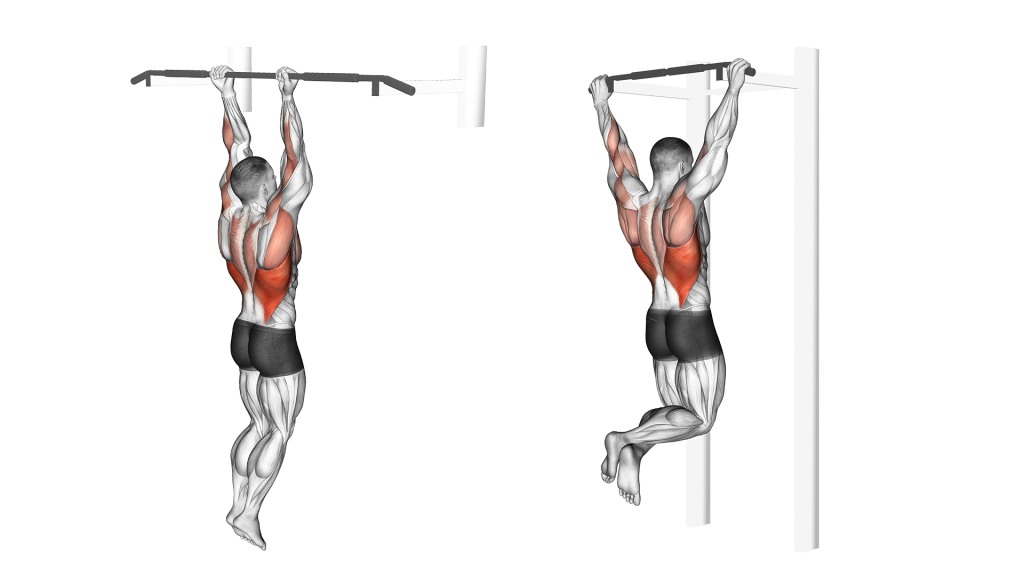
Because of how widely vertical pulling exercises can vary in terms of mechanics or equipment, they are more often differentiated by the actual direction in which the body or source of resistance is moving - that is, along a vertical path.
Vertical pull exercises tend to target the muscles of the upper back in a way that horizontal pulling movements do not - hence the need for both types of pull exercises in an effective training routine.
The most common examples of a vertical pulling exercise are the pull-up and chin-up - both of which involve the body pulling itself upwards.
Benefits of Vertical Pull Exercises
Apart from the usual benefits one would see from performing exercise in general, there are several other training goals that are uniquely fulfilled by performing vertical pull exercises.
This is primarily due to their characteristic muscular recruitment pattern, and the fact that nearly all vertical pulling exercises are of a highly dynamic and compound nature.
Excellent for Developing Upper Back Musculature
Although not all exercises featuring a vertical pulling movement will train the entire back, the general trend is that the latissimus dorsi and biceps brachii are involved to some extent.
Lifters seeking greater strength and mass in their upper back will find that a combination of targeted isolation work and high-intensity vertical pulling exercises is their best bet.
Carryover to Many Athletic Activities
Though pull-ups may appear as if they have no real world applicability outside of general muscular improvement, the majority of vertical pulling exercises (including pull-ups) actually carry over quite well to a number of different athletic activities.
Rock climbers, swimmers and parkour artists can benefit greatly from not only the physical developments produced by vertical pulling movements, but also from the reinforcement of general upper body pulling mechanics and less obvious skills like proprioception or maintaining a rigid core while in a state of suspension.
Improved Posture
Poor posture is a result of weak musculature and poor mobility in certain joints of the upper body.
Fortunately, with regular performance of vertical pull exercises, the lifter will see a marked improvement in their posture due to the reinforcement of the muscles responsible for maintaining proper posture (i.e. the trapezius and erector spinae), as well as from the improved shoulder and upper back mobility derived therein.
Lower Impact Than Horizontal Pulling Movements
Horizontal pulling movements often include exercises like the barbell row or deadlift - both of which are known to place some level of strain on the joints of the body.
While such impact is unlikely to result in injury if proper form is followed, vertical pulling exercises offer one possible alternative for lifters who wish to minimize the amount of pressure placed on their connective tissues.
This is not to say that vertical pulling exercises are entirely safe, only that they place less pressure and force on the joints in comparison to their horizontal pulling counterparts.
Vertical Pull Exercises
1. Pull-Ups
The most classic example of a vertical pulling movement is that of the pull-up; a multi-joint compound exercise traditionally performed with bodyweight as the sole source of resistance.
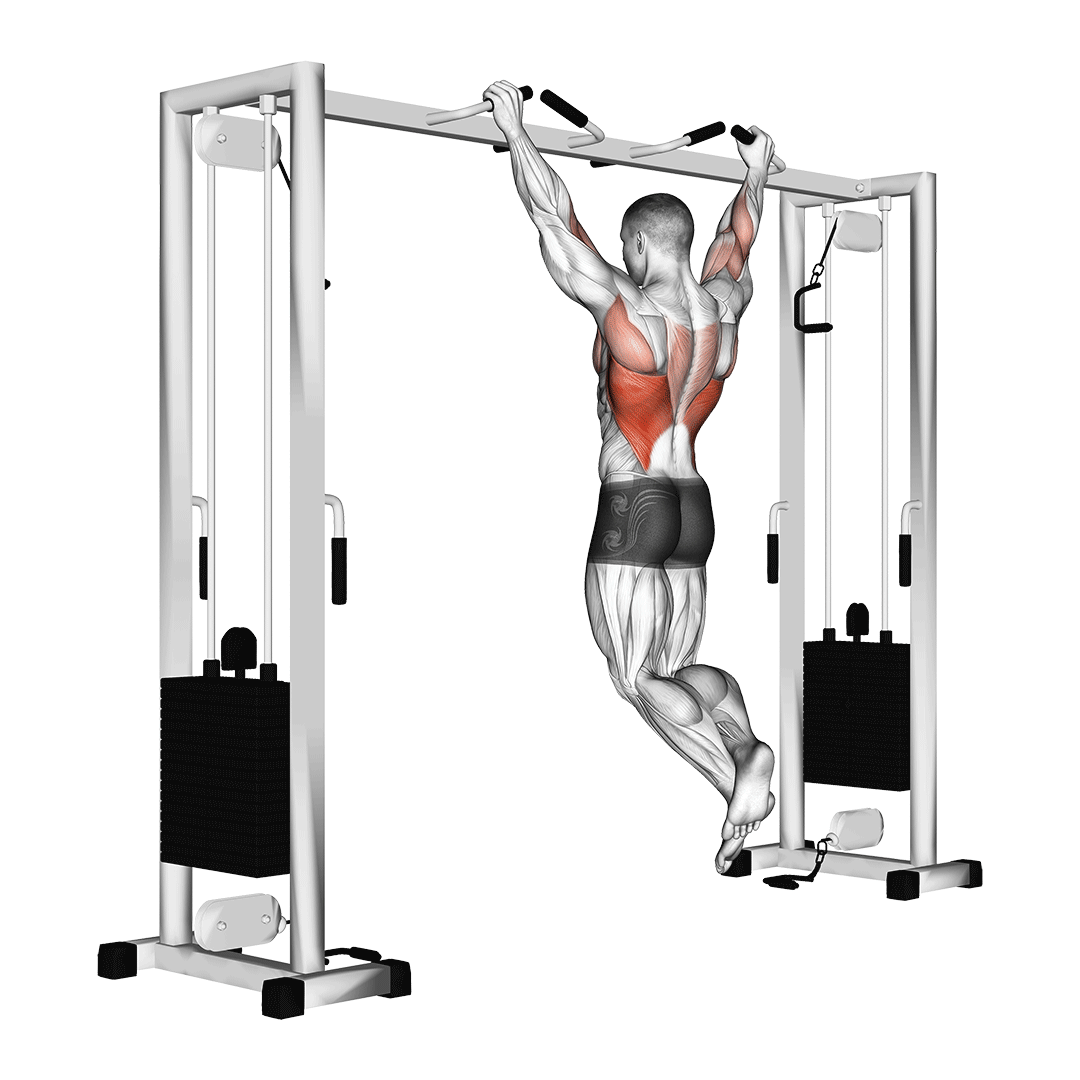
The pull-up has earned a reputation as being one of the most effective back-and-bicep exercises available, often being performed alongside weighted exercises despite the fact that it is conventionally a calisthenic movement.
Because of the popularity of the pull-up, quite a number of possible variations have been developed to further improve upon its many benefits.
Lifters unable to perform conventional pull-ups may benefit from machine-assisted pull-ups, whereas those at a highly advanced level of strength may further specialize into muscle-ups, and athletes seeking greater explosiveness are known to perform kipping pull-ups.
Muscles Worked
Pull-ups will recruit the muscles of the latissimus dorsi, trapezius, biceps brachii, the teres muscles and rhomboids to great effect.
In terms of isometric contraction, muscles like the abdominals, erector spinae and brachialis are also recruited.
Equipment Needed
Pull-ups only need an overhead pull-up bar or similar implement, making them one of the most accessible vertical pulling exercises out there.
How-to:
To perform pull-ups, the exerciser will begin with a dead hang position from a pull-up bar, gripping it in an overhand position.
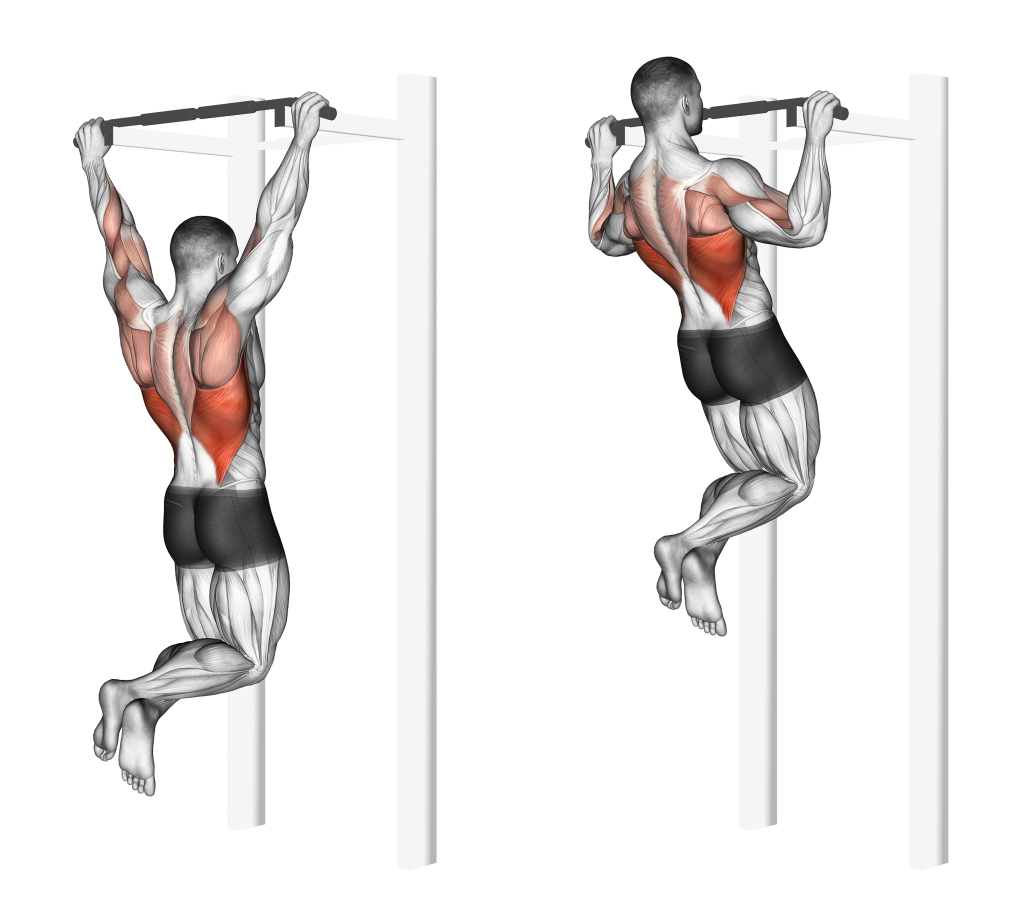
Then, to start the repetition, the lifter will bend at the elbows and contract their lats, drawing their chest towards the bar as they squeeze their core musculature so as to avoid swinging of the lower body.
Once the pull-up bar is beneath the head, the lifter will slowly reverse the motion until they have returned to the original dead hang position, thereby completing the repetition.
2. Chin-Ups
Considered to be the sister-lift to the pull-up, the chin-up is quite simply a pull-up performed with the hands set closer together in a supinated grip. This produces greater emphasis on the muscles of the arms, and may make the movement easier to perform due to a more advantageous positioning.

Delving deeper into the chin-up, we can see that it is a multi-joint compound movement traditionally performed with only the exerciser’s own body as a source of resistance - although several further variations like the assisted chin-up or weighted chin-up change this somewhat.
In practice, the chin-up is used either as the main source of back-and-arm training stimulus within a workout, or as a secondary compound movement after heavier exercises like the barbell row or deadlift have already been completed.
Muscles Worked
Chin-ups train the latissimus dorsi, trapezius, posterior deltoid head, rhomboids, teres major, the biceps brachii, as well as the brachioradialis and brachialis.
In terms of stabilizer muscles, the core and erector spinae are utilized as well.
Equipment Needed
Chin-ups require only an overhead pull-up bar to perform.
How-to:
To perform a repetition of the chin-up, the lifter will hang from a pull-up bar with their hands in a supinated grip, the core contracted so as to prevent the lower body from swinging.

Then, bending at the elbows and squeezing the latissimus dorsi, the lifter will draw their torso upwards until their head is higher than the bar.
To complete the repetition, the lifter will simply reverse the motion in a slow and controlled manner, returning to their starting position.
3. Lat Pulldowns
Lat pulldowns are a machine-based compound exercise known for being highly effective at building up the muscles of the upper back, especially in regards to the latissimus dorsi.
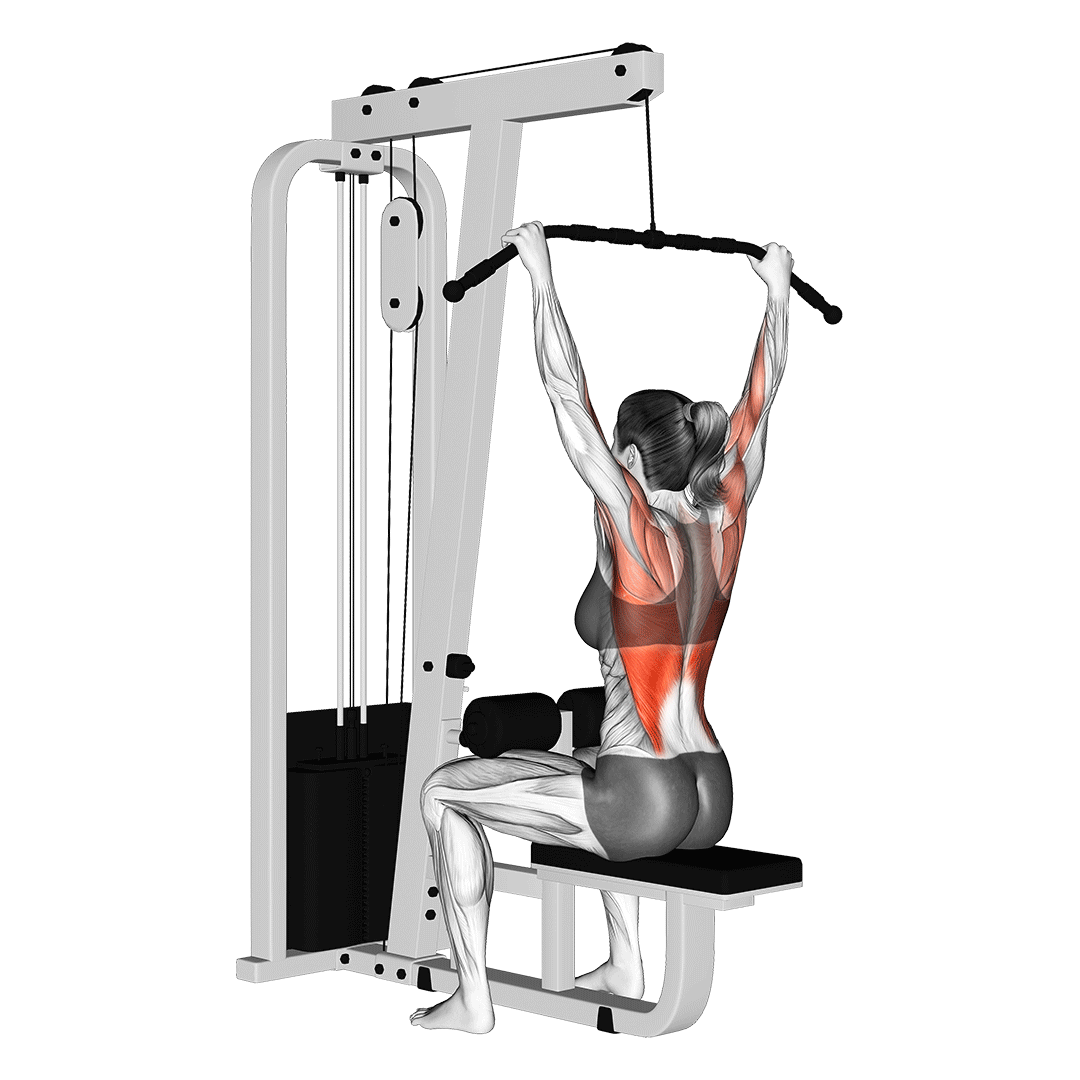
In terms of mechanics and muscular recruitment, lat pulldowns are considered to be quite similar to conventional pull-ups, only with far less stabilizer muscle recruitment due to the fact that it is a machine-based exercise, and that it is primarily performed in a seated position.
Lat pulldowns are often used as an accessory exercise alongside movements like the pull-up or barbell row, as they can allow for greater training volume of the back-and-biceps to be achieved in a highly adjustable and safe manner.
Muscles Worked
Lat pulldowns will recruit the latissimus dorsi, trapezius, infraspinatus, rhomboids and the posterior deltoid head. Depending on grip width, the biceps may also be used as either a primary mover or stabilizing muscle.
Equipment Needed
Lat pulldowns will require a lat pulldown machine or a cable machine with a straight bar attachment.
How-to:
Sitting within the machine, the lifter will extend their arms overhead and grip the bar in an overhand position, keeping the hands wider than shoulder width apart.
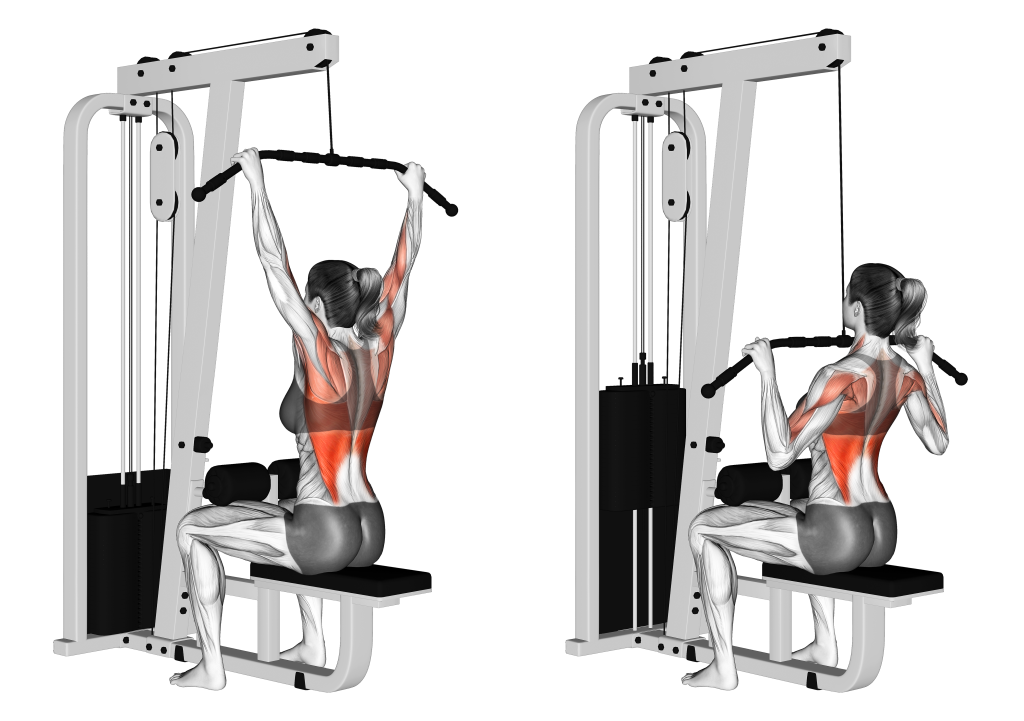
Keeping the chest pushed out, the lifter will bend at the elbows and pull the bar towards their torso, stopping once it is at approximately clavicle-height.
The lifter will then slowly reverse the motion and extend their arms back overhead, thereby completing the repetition.
4. Reverse Shrugs
An accessory compound exercise performed with the use of a lat pulldown machine, the reverse shrug not only builds muscle mass in the inner section of the upper back, but also reinforces scapular retraction in a manner that reduces any future risk of injury.
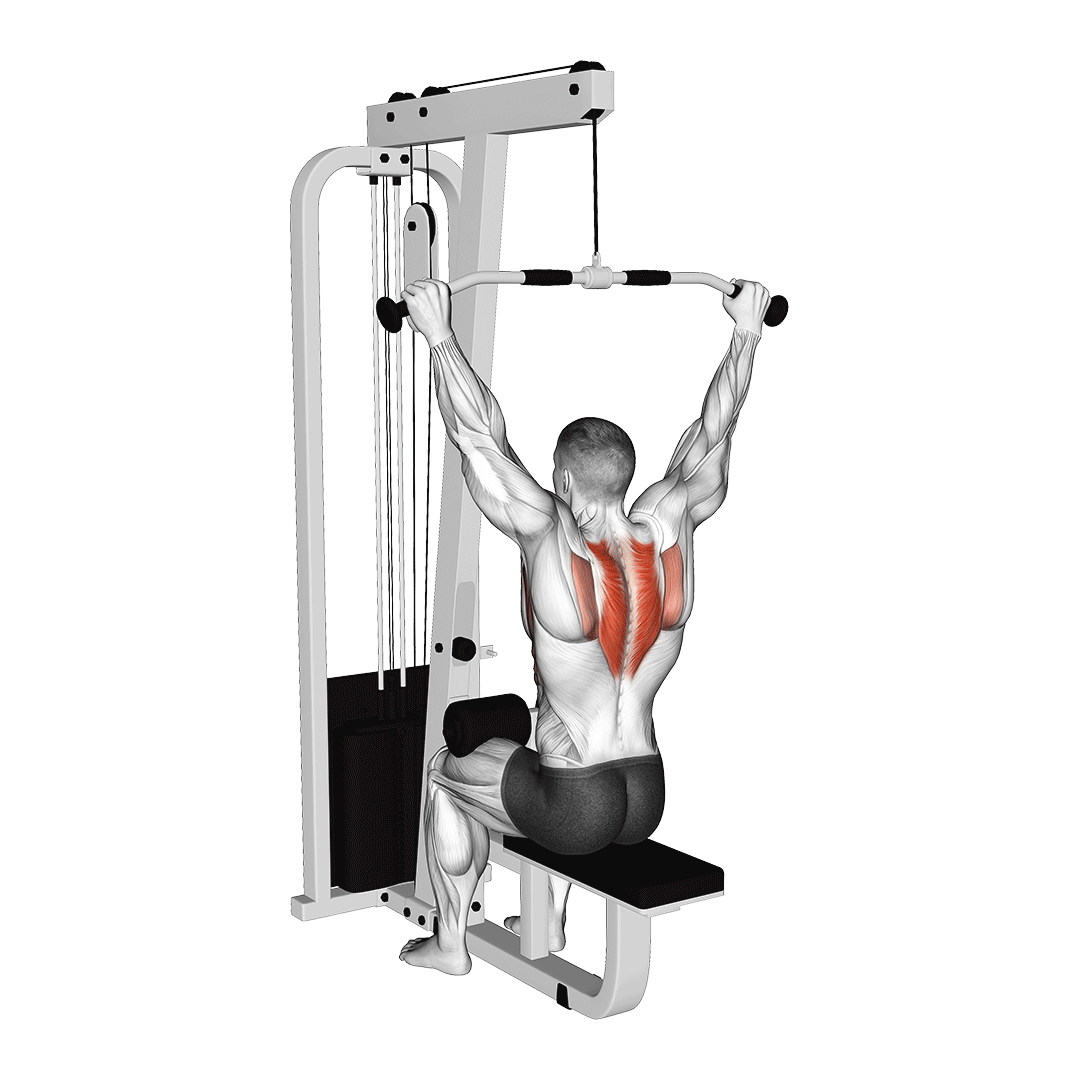
The reverse shrug is most often used during the latter phase of a workout session, or as a rehabilitative tool for scapular depression and retraction.
Muscles Worked
Reverse shrugs primarily target the trapezius, but will also work the latissimus dorsi as a secondary mover muscle.
Equipment Needed
Reverse shrugs are performed with the use of a lat pulldown machine or a cable machine with a straight bar attachment.
How-to:
Sitting in the lat pulldown machine with the hands gripping the bar wider than shoulder-width apart, the lifter will externally rotate the shoulders and draw the shoulder blades together, depressing them as they do so.
To complete the repetition, the lifter will then raise their shoulders upwards before returning to the starting position, ensuring that the shoulders remain externally rotated throughout the exercise.
5. Vertical Tractions
The vertical traction machine is a lesser-known vertical pulling exercise best used as a secondary compound movement to target the upper back and biceps.
It is multi-joint and compound by nature, and is most often compared to a lat pulldown despite the drastically different angles of resistance and grip in either movement.
In particular, vertical tractions are most effective when used for a moderate amount of resistance and a high amount of volume - especially alongside other exercises that target the latissimus dorsi and biceps, such as chin-ups and rows.
Muscles Worked
Vertical tractions primarily target the latissimus dorsi, but will also recruit the biceps brachii, rhomboids and trapezius to a certain extent as well.
Equipment Needed
Vertical tractions are rather unique, and as such can only really be performed with a vertical traction machine.
How-to:
Sitting within the machine with the hands gripping both handles overhead, the lifter will contract their core and push their chest outwards before beginning the repetition.
To begin the repetition, the lifter will flex their lats and draw the elbows downwards and backwards, pulling the shoulder blades together as they do so.
Once the elbows are below the shoulders along a horizontal plane, the lifter will simply reverse the motion in a slow and careful manner - thereby completing the repetition.
6. Vertical Rope Pulls
For a more dynamic and athletically-inclined vertical pulling exercise, lifters may try the vertical rope pull machine - or what is occasionally called the “endless” rope trainer machine.
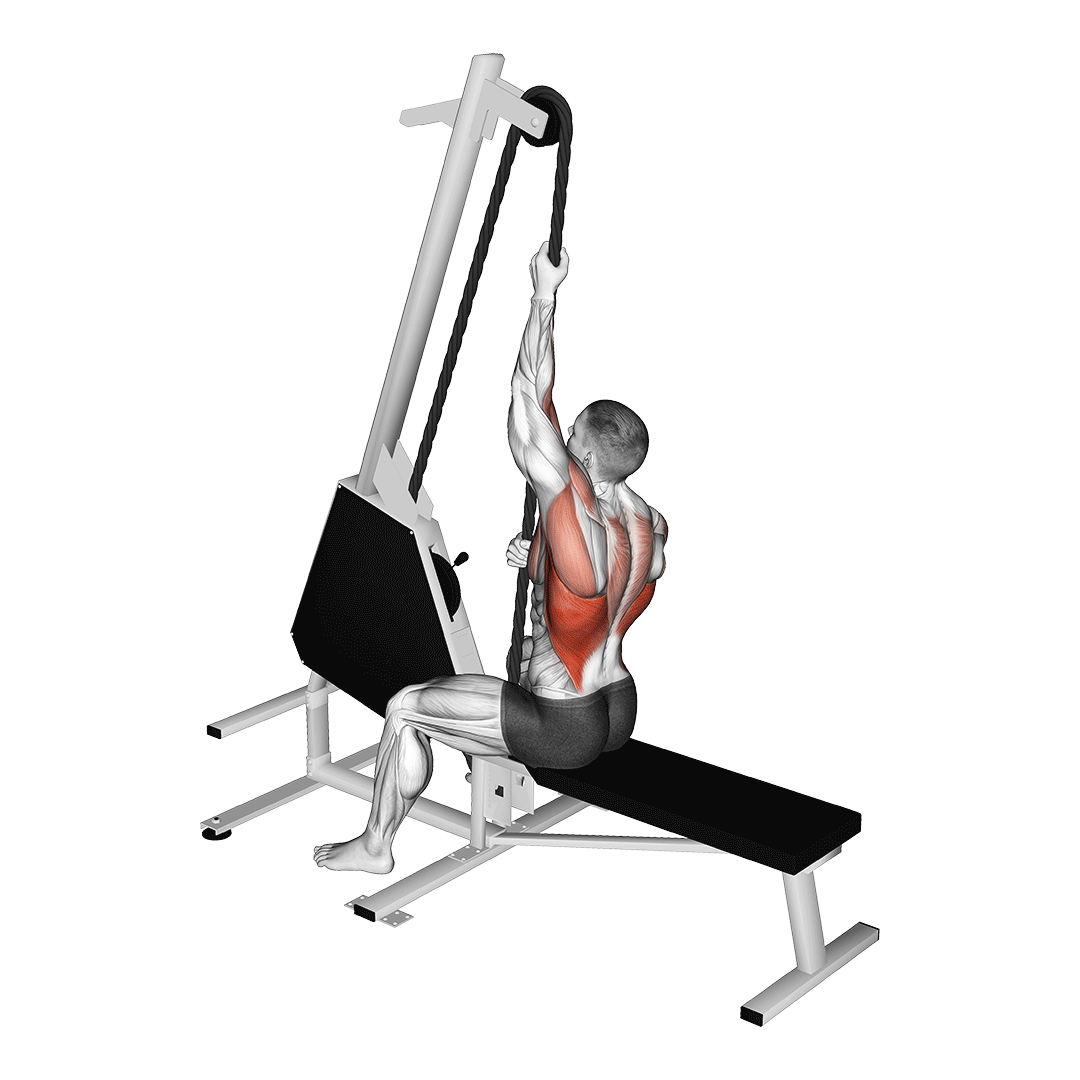
Mechanically similar to a lat pulldown but with a more natural grip and unilateral nature, the vertical rope pull quite simply involves the lifter pulling a rope from an overhead pulley so as to train the forearms, biceps, and the entirety of the upper back.
Vertical rope pulls are a machine-based multi-joint compound exercise, and are generally performed for length of time per set, rather than number of repetitions.
Muscles Worked
Vertical rope pulls train the forearms, biceps brachii, posterior deltoid head, latissimus dorsi, rhomboids, infraspinatus and the trapezius - all to a highly dynamic and intense capacity.
Equipment Needed
Vertical rope pulls will require a vertical rope pulling machine.
How-to:
Sitting (or standing) at arms length from the rope of the machine, the lifter will simply place one hand along the rope and draw it downwards, following suit with the opposite arm. The movement should include the entirety of the back, ensuring that it is not solely an arm exercise.
For the best results, the pulling hand should not release the rope until it is below navel-height, and each pull of the rope should be performed in a slow and controlled manner.
Frequently Asked Questions (FAQ)
What are Vertical Pull and Push Exercises?
Vertical pull and push exercises are simply movements involving force directed along a vertical plane.
Vertical pulling exercises involve either drawing an object towards the body along a vertical path, or drawing the body towards an object along the same plane - such as in the case of the pull-up.
Vertical pushing exercises are the opposite, where an object is pushed away from the body along a vertical path. One good example of this is the barbell military press.
How to do Vertical Pull Exercises at Home?
The pull-up and chin-up both require only a minimal amount of equipment, and are entirely doable within the comfort of your own home. If needed, you can also set up a makeshift lat pulldown with the use of a resistance band.
How Do You Do Vertical Pull Exercises With Dumbbells?
Unfortunately, the majority of vertical pulling exercises cannot be done with a dumbbell.
The upright row may be the closest thing to a dumbbell-based vertical pulling exercise, but is largely ineffective for targeting many of the muscles normally trained by vertical pulling exercises, such as the latissimus dorsi and the teres muscle group.
In Conclusion
Creating an effective vertical pulling workout requires a bit of creativity, but is nonetheless doable with the right sort of equipment.
Remember that proper exercise selection is only a small portion of what makes an effective training program, and that it is important to perform each exercise with the correct technique so as to avoid injury.
References
1. Lorenzetti, Silvio, Romain Dayer, Michael Plüss, and Renate List. 2017. "Pulling Exercises for Strength Training and Rehabilitation: Movements and Loading Conditions" Journal of Functional Morphology and Kinesiology 2, no. 3: 33. https://doi.org/10.3390/jfmk2030033
2. Handa, T.; Kato, H.; Hasegawa, S.; Okada, J.; Kato, K. Comparative electromyographical investigation of the biceps brachii, latissimus dorsi, and trapezius muscles during five pull exercises. Jpn. J. Phys. Fit. Sports Med. 2005, 54, 159–168.
